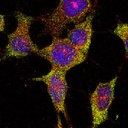Bone marrow microenvironment confers imatinib resistance to chronic myelogenous leukemia and oroxylin A reverses the resistance by suppressing Stat3 pathway.
Sleutelwoorden
Abstract
Imatinib (IM) is highly effective in treatment of chronic myeloid leukemia (CML) but does not eliminate minimal residual disease (MRD), which remains a potential source of relapse. IM treatment effectively inhibits BCR-ABL kinase activity in CML cells, suggesting that additional kinase-independent mechanisms contribute to the presence of MRD. Bone marrow (BM) microenvironment protecting CML cells from IM treatment was investigated. Culturing CML cell line K562 in human stromal cell line HS-5-derived conditioned medium significantly inhibited apoptosis induced by IM, which was soluble factor-mediated drug resistance (SFM-DR). The BM stroma-derived soluble factors could enhance the resistance of K562 cells to IM by increasing Stat3 phosphorylation on tyrosine 705 and subsequently increasing the expression of anti-apoptotic proteins and P-glycoprotein (P-gp) in K562 cells. Furthermore, the reversal effect of oroxylin A, a naturally monoflavonoid isolated from the root of Scutellaria baicalensis Georgi, in K562 cells within the SFM-DR model was detected. After treatment of weakly toxic concentration of oroxylin A, the apoptosis of K562 cells induced by IM was increased dramatically through suppressing Stat3 pathway. In addition, the in vivo study showed that oroxylin A potentiates the inhibitory effects of IM on leukemia development by suppressing Stat3 pathway in the K562 xenograft model. In conclusion, IM-induced resistance in K562 cells within the SFM-DR model correlated with increasing Stat3 signaling and upregulating P-gp expression through Stat3 pathway. Additionally, oroxylin A improved the sensitivity of K562 cells to IM in SFM-DR model and in vivo, and the underlying mechanism attributed to the suppression of Stat3 pathway, which suggested oroxylin A might be a promising agent for treatment designed to eradicate MRD in CML patients.






